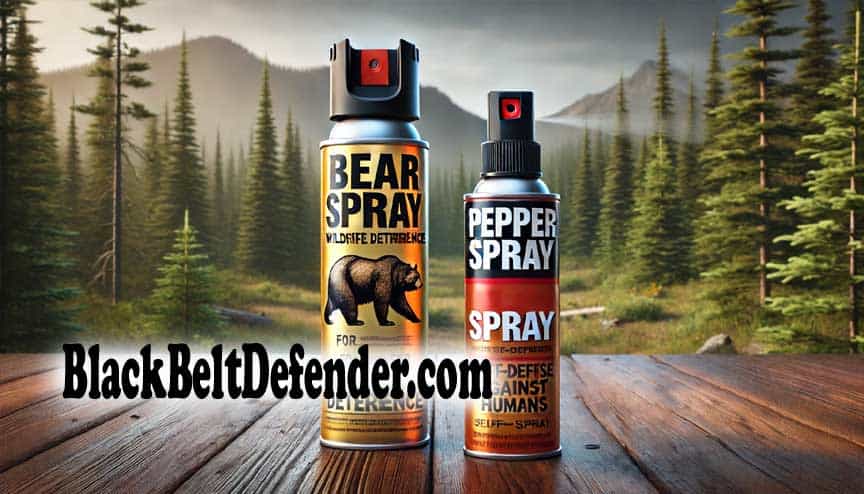
free shipping on orders over $49
We're having a 15% off sale on all our products. Enter your email below to be notified about future sales.




No, pepper spray and bear spray aren’t the same. While both contain capsaicinoids, bear spray has a higher concentration, making it 50% stronger than pepper spray. You’d use bear spray to deter bears, thanks to its wider spray range and high success rate. It’s also strictly regulated by the EPA and illegal to use on humans. On the other hand, pepper spray is for self-defense against human threats, with a shorter range and focused spray pattern. Knowing the differences in composition, usage, and legalities is crucial for your safety. Choosing the right spray hinges on understanding these distinctions.
Pepper spray and bear spray may seem similar at first glance, but they’re designed for entirely different adversaries. When you’re weighing Bear Spray Vs Pepper Spray, it’s important to grasp the key differences that define their use.
The concentration of capsaicin, a critical component responsible for the spray’s irritating effects, is higher in bear spray, with a 2.0% Major Capsaicinoids content. This is in contrast to pepper spray, which typically features a 1.0% to 1.33% range. This difference in concentration is significant, as it affects the efficacy of the sprays against their intended targets.
Moreover, bear spray boasts a longer range of up to 40 feet, outdistancing pepper spray’s shorter reach. This extended range is particularly important in bear encounters, allowing you to establish a safety barrier without getting too close. The efficacy rates align with their intended purposes; bear spray’s success rates in deterring bear attacks hover between 90-98%, while pepper spray’s effectiveness is directed at human attackers.
Understanding the differences between bear spray and pepper spray prepares you to explore their specific purposes and how they’re used in various situations. Pepper spray is designed primarily for self-defense against human attackers. It causes temporary blindness and intense irritation, making it a key tool for personal safety and home security. On the other hand, bear spray is formulated to deter bears in the wilderness. Its higher concentration of capsaicin guarantees it’s potent enough to stop a bear in its tracks, recommended for those hiking, camping, or spending time in bear-populated areas.
Here’s a quick glance at their recommended usage and purpose:
| Spray Type | Recommended Usage | Purpose |
|---|---|---|
| Pepper Spray | Personal Safety, Home Security | Self-defense against humans |
| Bear Spray | Hiking, Camping, Bear Areas | Deter bears, wilderness safety |
| Key Difference | Higher concentration in Bear Spray | Specific target (Human vs. Bear) |
Delving into the chemical composition of bear and pepper sprays reveals important differences in their potency and regulatory oversight. At the heart of these differences are capsaicinoids, the active chemical compounds that make these sprays effective.
Bear spray contains 2% capsaicin and related capsaicinoids, designed by bear biologists to guarantee its efficacy and humane use in deterring bear attacks. This higher concentration contributes to its greater potency compared to pepper spray, which is intended for self-defense against humans. The strongest pepper sprays available to consumers contain only 1.33% capsaicin, while level one and level two pepper sprays contain less than 1%, making them notably less potent than bear spray.
Furthermore, the regulation surrounding the chemical composition of these sprays differs substantially. The Environmental Protection Agency (EPA) has more stringent regulations for bear spray, reflecting its specialized use and higher capsaicin concentration. This regulatory oversight ensures that bear spray meets specific standards for effectiveness and safety, in contrast to the less regulated and less potent pepper sprays.
Understanding these nuances in chemical composition and regulation is important when considering the intended use and effectiveness of each type of spray.
When comparing pepper spray and bear spray, you’ll notice significant differences in their active ingredient levels and intended uses.
While bear spray boasts a higher concentration of capsaicin to deter larger threats, pepper spray is optimized for human attackers with a slightly lower concentration.
Understanding these distinctions, along with how the spray range compares, is important for choosing the right defense tool in various situations.
In comparing pepper spray and bear spray, the active ingredient levels, specifically the concentration of Major Capsaicinoids, play an essential role in their effectiveness and intended use.
Bear spray, with a higher concentration of oleoresin capsicum, like the Frontiersman Bear Spray containing 2.0% Major Capsaicinoids, is notably more potent. This concentration makes it more effective at persuading a bear to turn away.
On the other hand, pepper spray, typically has a lower concentration of capsaicinoids, ranging from 1.0% to 1.33%. This difference in the Major Capsaicinoids level underscores the varying strength of pepper spray compared to bear spray, with bear spray being formulated to have a strength 50% greater to safeguard during bear encounters.
Understanding the intended uses of bear and pepper sprays reveals why their strength and concentration differ considerably.
Comparing the spray range of bear and pepper sprays reveals notable differences in their strength and concentration, important for their intended uses. Bear spray boasts a longer range of 20 to 40 feet, surpassing pepper spray’s modest reach of 10 feet or less.
This distinction isn’t just about distance; it’s about potency. Bear spray contains a higher concentration of capsaicin, with 2.0% Major Capsaicinoids, making it 50% stronger than the typical pepper spray, which ranges from 1.0% to 1.33% Major Capsaicinoids.
This increased strength and concentration make bear spray the recommended choice for bear encounters, ensuring a safer distance between you and a potential threat while providing a more potent deterrent.
When considering self-defense options against wildlife or human attackers, it’s important to recognize that bear spray can reach targets up to 40 feet away, whereas pepper spray is effective at distances of 10 feet or less. This significant difference in range means that you’ll need to be much closer to a potential threat when using pepper spray, which could increase the risk in certain situations.
Bear spray’s wider coverage area is designed to create a barrier between you and an approaching bear, maximizing your safety during such encounters. On the other hand, pepper spray’s pattern is more focused, intended to incapacitate a human assailant quickly. The effectiveness of these sprays not only relies on their concentration but also on how they’re deployed. Here are key points to remember:
Understanding these differences helps you use the right spray for the right situation, enhancing your safety and the effectiveness of your self-defense strategy.
Understanding the legal landscape surrounding the use of bear and pepper spray is essential for ensuring you’re within the bounds of the law. Bear spray, with its higher oleoresin capsicum percentages—up to 2%—is specifically designed and regulated for deterring bears. Its use against humans is illegal due to the potent concentration of its active ingredient, capsaicin, which can cause intense shortness of breath and strong psychological effects. On the other hand, pepper spray contains lower concentrations of capsaicin, making it suitable for self-defense against human attackers, allowing you to escape to safety without causing long-term harm.
It’s important to know that while you can legally use pepper spray for personal protection, deploying it in non-threatening situations or against law enforcement can lead you dangerously close to legal repercussions. The distinction in legality underscores the importance of using these sprays as intended: pepper spray for defense against humans and bear spray for bear encounters. Misuse of either, especially using bear spray on humans, can lead to serious legal consequences, emphasizing the need for responsible and informed use.
After exploring the legal aspects, let’s now examine the safety and effectiveness of bear and pepper sprays in their intended scenarios.
Pepper spray and bear spray serve distinct purposes, each designed to maximize safety and effectiveness within their specific context. Here’s a breakdown:
When deciding between pepper spray and bear spray, you’ll need to take into account their ingredients, how they’re used, and any legal restrictions.
Understanding the differences in their formulations and the distances they can cover will steer you towards the right choice for your situation.
It’s important to know when and where each type is most effective to guarantee your safety.
Analyzing the ingredients in bear spray and pepper spray reveals key differences that’ll guide your choice, depending on whether you’re facing a wild animal or a human threat. Both sprays contain oleoresin capsicum, yet their concentration and strength vary greatly, impacting their deterrence success rate.
Understanding the ingredients in bear and pepper sprays helps you see why selecting the appropriate option for your safety scenario is important.
Bear spray, designed to deter bear encounters, boasts a longer range, up to 40 feet, ensuring you can keep a safe distance. However, it’s illegal and unsafe to use it on humans because of its high potency.
On the flip side, pepper spray is formulated for personal safety against human attackers or dogs. Its lower concentration of capsaicin doesn’t provide the strength or reach needed to effectively deter bears.
Therefore, choosing the right spray—bear spray for wilderness activities and pepper spray for defense against humans—is essential for your safety.
No, bear spray isn’t as strong as you might think compared to pepper spray when it comes to chemical composition. Despite having a different spray mechanism and usage training, its effect duration and range difference are key.
You shouldn’t use bear spray on humans for self-defense due to legal implications, safety concerns, and potential emotional trauma. Consider alternative defenses with shorter spray duration, less environmental impact, and a safer spray range.
Bear spray contains a 2.0% OC concentration, making it extremely important for wildlife protection. It’s essential to follow legal restrictions, safety measures, and usage guidelines to minimize environmental impact while ensuring your safety.
Yes, bear spray can stop a grizzly by impacting its behavior. It’s essential for attack prevention, with a long spray range. Mind wind effects and spray duration. Always follow safety practices and wildlife ethics.
As always, be safe and be prepared.
See Also:
Black Belt Defender
1867 Caravan Trail #105
Jacksonville, FL 32216-2006
Call us toll-free: (800) 859-5566
Mon-Fri: 9:00 am – 5:00 pm EST
NH based, FL Warehouse
Online Orders: 24/7/365

